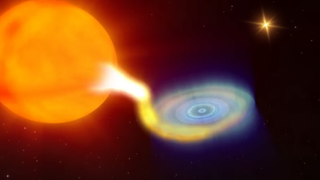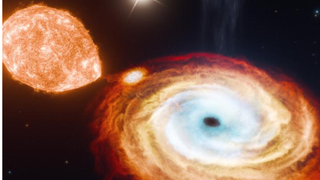1st triple black hole system discovered in 'happy accident'
"Overall, it's not surprising that black holes should be in triples, but what's surprising is that this system held onto the outer star after forming the black hole."

Astronomers have discovered the first "black hole triple" system, consisting of a black hole hungrily feeding on a companion star while being orbited by a more distant, cautious star.
Black holes form during the violent death of massive stars in supernova explosions, but this surprising discovery could indicate a more gentle black hole birthing process called "direct collapse." That is because if the origin of this black hole had been more violent, it would have supplied a "pre-natal kick" that would have launched the loosely bound distant star out of this triple star system.
The system in question is V404 Cygni, located within the Milky Way and around 8,000 light-years from Earth. This so-called "X-ray binary" of the black hole and its victim star were previously known, and the system has been well-studied. However, a deeper investigation performed by a team led by Kevin Burdge from the Massachusetts Institute of Technology (MIT) revealed that this binary actually sits at the heart of a triple star system.
Scientists think most black holes form from violent explosions of stars, but this discovery helps call that into question.
"This system is super exciting for black hole evolution, and it also raises questions of whether there are more triples out there," Burdge told Space.com via email. "The fact that this star is still bound is surprising because it implies it received a low-energy natal kick.
"Overall, it's not surprising that black holes should be in triples because a large fraction of massive stars are in triples, but what's surprising is that this system held onto the triple after forming the black hole."
Related: NASA peers into the blistering hot plasma swirling around 12 black holes
The team has found that while the "victim star" of this black hole orbits it in just 6.5 Earth days, the newly uncovered third star in the system orbits the greedy cosmic titan so far away it only completes an orbit once every 70,000 Earth years.
Get the Space.com Newsletter
Breaking space news, the latest updates on rocket launches, skywatching events and more!
"This discovery was just a happy accident, actually! I was just looking at a picture of V404 Cygni and noticed it was in a triple," Burdge said. "What we then discovered is that the black hole in V404 Cygni likely was born without a natal kick.
"That doesn't mean all black holes don't get natal kicks, but it does demonstrate that at least some can form without them."
The team's research was published on Wednesday (Oct. 23) in the journal Nature.
Well known black hole still hides secrets
Astronomers have known about the supernovas that accompany the death of a massive star after it has run out of nuclear fuel at its core and can no longer support itself against their own gravity for centuries.
When Einstein's theory of general relativity set scientists on a path that led to the discovery of black holes and neutron stars, these bright and violent cosmic explosions were quickly linked to the birthing process of these ultradense stellar corpses.
The sheer power of these events means that they are often brighter than the combined light of every star in the galaxy that surrounds them. It also means that they supply any orbiting stars with an energetic kick when they erupt.
"The prenatal kicks are net momentum the black hole receives after its birth. So, for example, if you have a supernova and the matter gets ejected asymmetrically, to conserve momentum, the black hole gets kicked in the opposite direction of the matter," Burdge said. "It's really hard to constrain these pre-natal kicks partially because we have so few known black holes in the Milky Way, and also, because there aren't many good ways to measure them other than through a wide triple companion like is seen in this system."

A close star that is tightly bound gravitationally to the new black hole may survive the energy it receives from this supernova explosion and remain in the system. Gravity's strength falls off quickly over large distances, however, meaning any distant stars not tightly held by the black hole should be ejected to wander the cosmos as a "rogue star."
"Imagine you’re pulling a kite, and instead of a strong string, you’re pulling with a spider web," Burdge explained in a statement from MIT. "If you tugged too hard, the web would break, and you'd lose the kite. Gravity is like this barely bound string that's really weak, and if you do anything dramatic to the inner binary, you’re going to lose the outer star."
So why didn't that happen in this black hole triple?
Three's not a crowd for this black hole
Before answering this question, the team first had to confirm that this distant star is definitely orbiting the inner binary of V404 Cygni. They did this using 10 years of observations from the Gaia space telescope, a spacecraft that precisely monitors the motion of billions of stars in the Milky Way.
The team found the stars do indeed move in tandem, finding that the odds of this kind of motion resulting from the stars not sharing the same system are about one in 10 million. They also determined that the outer star is 3,500 times farther from the central black hole than Earth is from our sun.
"The fact that we can see two separate stars over this much distance actually means that the stars have to be really very far apart," Burdge said in the statement. "It's almost certainly not a coincidence or accident. We're seeing two stars that are following each other because they’re attached by this weak string of gravity. So this has to be a triple system."
To determine why the outer star of this system hadn't been kicked away into space, Burdge ran a number of simulations to see how such a black hole triple system could have evolved to its present state and still retain its outer star.
Each simulation began with three stars, one of which then transformed into a black hole. A supernova explosion is introduced to the simulations, which Burdge conducted tens of thousands of times, varying the amount of energy released and the direction in which the energy was released. Few of these simulations resulted in a black hole triple system.
For the most part, the only simulations that replicated the team's observations of this system were those that eliminated a supernova explosion and saw the black hole created by direct collapse.
"The vast majority of simulations show that the easiest way to make this triple work is through direct collapse," Burdge said.
Finding that this outer star is linked to V404 Cygni has also helped the team determine the age of the black hole triple system. That's because the distant star is in the process of transforming into a red giant star, something that occurs as stars move out of their main sequence phase and puff out to as much as 100 times their original width.
"The third body is actually quite interesting! In addition to its super wide orbit, the star happens to be evolving into a red giant right now, which lets us get the age of the system," Burdge said via email.
The team determined from this transformation that the outer star is around 4 billion years old and concluded that the entire system shares its age. This is the first time scientists have performed such an aging process.
"We've never been able to do this before for an old black hole," Burdge said. "Now we know V404 Cygni is part of a triple; it could have formed from direct collapse, and it formed about 4 billion years ago, thanks to this discovery."
The team still has questions about the nature of this system, which they will investigate in addition to searching for more black hole triples.
"One of the biggest questions is what the orbit of the outer companion looks like — is it circular or eccentric? We will try to measure this using an instrument called GRAVITY on the European Very Large Telescope (VLT)," Burdge concluded in his email. "As of right now, it's the only known black hole triple, but we are conducting an ongoing campaign to find more of them!"
Join our Space Forums to keep talking space on the latest missions, night sky and more! And if you have a news tip, correction or comment, let us know at: community@space.com.

Robert Lea is a science journalist in the U.K. whose articles have been published in Physics World, New Scientist, Astronomy Magazine, All About Space, Newsweek and ZME Science. He also writes about science communication for Elsevier and the European Journal of Physics. Rob holds a bachelor of science degree in physics and astronomy from the U.K.’s Open University. Follow him on Twitter @sciencef1rst.
-
Galumph Makes me wonder if some of the accreted matter gets recycled in the black holes' astrophysical jets. That is, I wonder if there's enough energy in those jets to create hydrogen atoms, which in turn form stars. We see the gamma-ray signature of electron-positron annihilation in these astrophysical jets, and we know pair production can occur in such extreme environments. Just a thought.Reply -
billslugg The energy in a positron-electron annihilation is 1.022 MeV. The energy needed to make a proton is a thousand times higher, around 1 GeV which is 1E9 eV. Earth's atmosphere gets hit by particles of energy 1E20 eV. So, yes, there would seem to be the ability in a BH jet to make hydrogen.Reply
